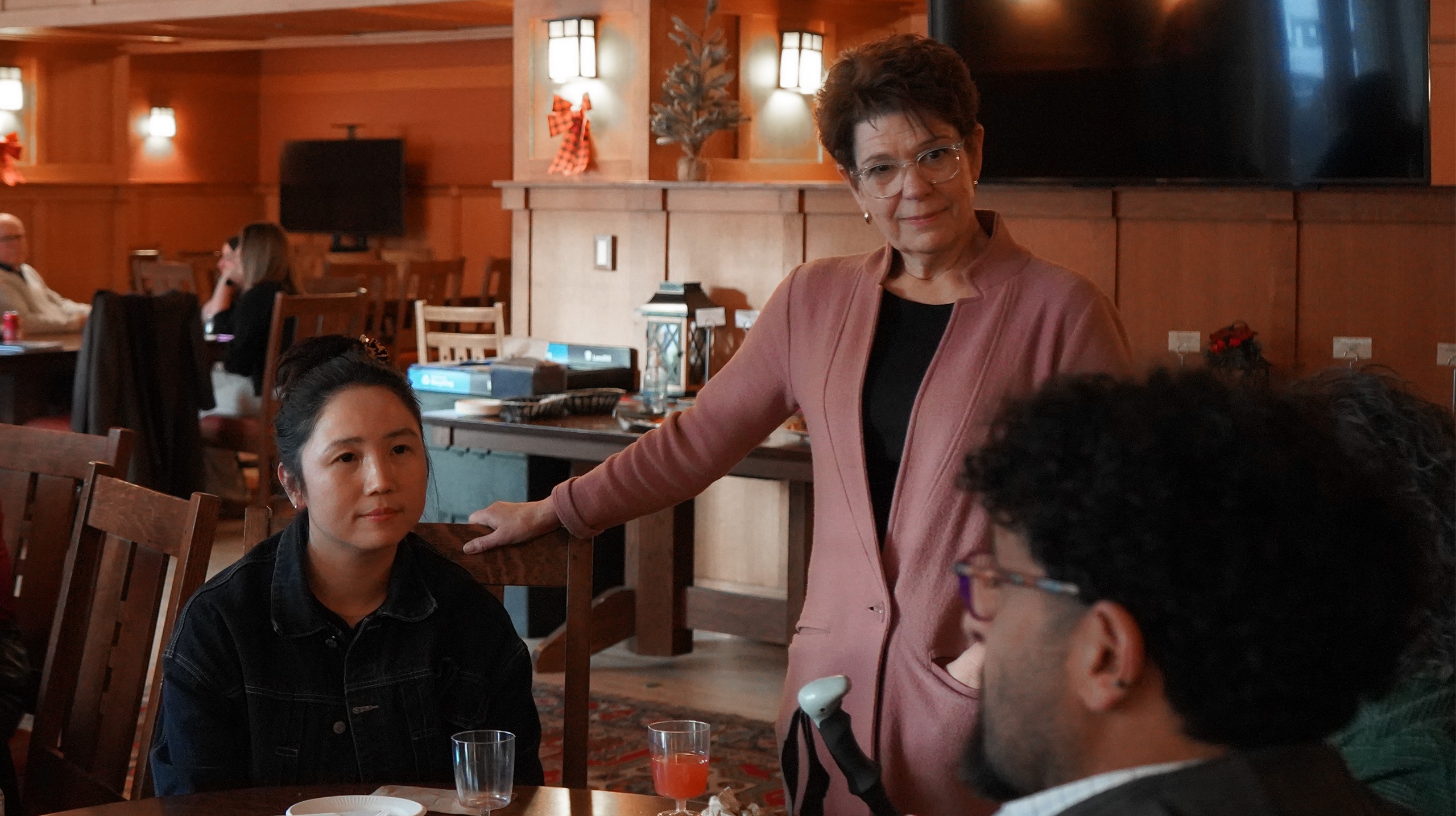It seems like almost everyone is now calling themselves a coach: a life coach, an executive coach, a leadership coach, a spiritual coach. Coaching has seen immense growth in the last five years. As the term “coaching” becomes more popular, more conversations emerge about coaching. When you have these conversations, it’s interesting to see what coaching is and what it isn’t.
Table of contents
- Are you ready to coach or be coached?
- Is coaching appropriate for your situation?
- How to have a coaching conversation
- How to enhance your coaching skills
- Let’s get coaching!
Are you ready to coach or be coached?
The power of coaching
Findings from the International Coaching Federation’s 2017 Consumer Awareness Study show that coaching has the power to provide:
- improved communication skills
- increased confidence
- increased productivity
- optimized individual and team performance
- improved work/life balance
What is coaching exactly?
According to the International Coaching Community, coaching “unlocks a person’s potential to maximize their performance. Coaching helps them to learn rather than teaching them.” Coaching is often described in many ways. Despite what term or phrase you may use to describe coaching, at the end of the day it’s really the power of the conversation.

Coaching is about getting to action. If we have a conversation and there is no action at the end, it’s just a nice conversation. A coaching conversation directs and drives the other individual towards action. It’s about maximizing the potential within somebody. It’s through questioning and holding space for an individual to help them discover their own path.
To coach someone, they must be open to it
When someone is in a space where they can make choices and decisions about their future, coaching can be beneficial. However, if somebody is stressed out, they are not making good rational choices and they are not open to a coaching conversation. We need to calm down first and be more comfortable in the current moment to be able to receive a coaching conversation.
This person must be aware, open, and agree to be coached. If a person didn’t want to be coached and didn’t agree to be coached, it’s not a coaching situation and so the coaching-style conversation you are about to have simply isn’t going to land.
There needs to be an awareness of when you’re in a coaching conversation. There needs to be agreement on both sides of that table and both sides of the conversation that you are engaging in a coaching conversation in that moment. You don’t need to bring formality into anything. But if somebody doesn’t know that they’re being coached, they simply are not being coached.
When a coaching conversation is beneficial
A coaching conversation is valuable if that person is ready and committed to take action and do something differently. It is when people are ready for change and want something more in their career and their life. Sometimes a coaching conversation starts because somebody else has recognized potential within us that we maybe didn’t realize ourselves. Coaching is about providing a space for someone so they can take that next step to grow into more of their potential.
Is coaching appropriate for your situation?

You may be convinced that you are wanting to be a coach, but it is important to determine if the person you want to coach is at a spot where they are ready for it and that the situation is appropriate for coaching and not something else.
Coaching isn’t for everyone
If this person doesn’t have any goals right now, if they don’t want to make changes, or if there’s nothing that they want to do differently in their life, they might not be into or ready for a coaching conversation. Coaching conversations are not for everybody. And it isn’t for everybody all of the time.
It takes effort to change our mindset and challenge our own stories about where we are and how we want to grow. It takes effort to do things differently and try things and to go through the plan, to do them, to check it, to adjust it. Coaching is having somebody on the other end to help us navigate through that cycle, which is iterative. We keep going until we get it right.
A coaching relationship needs to be based on curiosity on both sides. It is about two individuals being really open and curious. If a coach is open and curious, but the person who wants to be coached is very closed off and doesn’t agree with the process, you’re probably not in a coaching conversation.
Not every conversation needs to be or should be a coaching conversation. Not everybody who is in an organization needs and/or wants to be coached. But when somebody does want to be coached and is open to that conversation, it is so powerful to be able to have somebody challenge their assumptions and challenge them to step beyond where they are into taking those future actions to be able to live into their potential.
Not every conversation is a coaching conversation
You may be ready to coach someone, and you think they would be open and ready. But sometimes the situation is not appropriate for a coaching conversation. Sometimes a coaching conversation can blend into other types of conversations. Understanding the context of the conversation you’re having is really important. If you’re preparing for a conversation that is about setting expectations or giving somebody direction or giving them feedback, your energy and your body language and how you show up, is going to look very different than when you’re going to show up for a coaching conversation. For a coaching conversation, you want to be a lot more open and curious. Curiosity is really that key to the coaching conversation.

The following examples illustrate situations that are not coaching conversations. Trying to have a coaching conversation in one of these sitautions will not heed the same results as a true coaching conversation if that is what you are wanting.
The difference between coaching and collaboration
Coaching differs from collaboration as collaboration is about working together to solve a problem. Together, both people’s inputs, opinions, and ideas form a joint solution that people are going to work towards to together. If you’re going into a coaching conversation, usually somebody is holding space for somebody else to work through something. Collaboration is two individuals working through a joint problem, situation, or idea together.
The difference between coaching and mentoring
The line between coaching and mentoring is very easy to cross. On the Coaching Mentoring Continuum, mentoring is helping lead somebody down the path, especially if they have not been down that path. Coaching is about an individual who has the answer within them. Mentoring is where an individual might have an idea, but has never walked down that path before. Mentoring is more talking and coaching is more asking and listening.
The difference between coaching and performance management
When an employee or a staff member is underperforming, we sometimes use the language of “we’re going to coach you.” However, if somebody’s underperforming, there is a different conversation for performance management. When we start to blend the two or mix those up, it starts to send mixed messages.
As leaders, we sometimes want to avoid having the hard conversations. We try to be nice and say, “Well, we’re going to coach you.” We never actually tell people that “we’re going to put you on a performance management plan. We want to make sure you have the skills and understand the expectations to do your job.” And so we couch it with nice language and never get to the point.
The difference between coaching and sympathetic advice
There are also conversations where you may remind people that you have an employee family assistance program. If somebody is struggling, they may come for a coaching conversation, but they’re dealing with something that is very stressful in their life. If there are huge changes in family dynamics at home, there’s a real push to be able to have a conversation with them, to remind them that there is support within your organization that they have access to.
The difference between coaching and feedback
If we’re seeking feedback or giving feedback, we are not helping somebody get to action on their own and helping them uncover their potential within themselves.
The difference between coaching and leadership
Leaders can use coaching as a part of their skillset, but many leaders have difficulty building the environment for coaching due to power dynamics and the fact that we are leaders in many aspects of our lives. Like a coaching conversation, leadership isn’t about you, but it starts with you and starts with analyzing who we are and how we’re showing up.
How to have a coaching conversation
Now that you have determined that you are ready to coach, and the other person is open and ready for coaching, it is time to have a coaching conversation.
What a coaching conversation looks like
This pyramid represents the coaching conversation.

Starting at the bottom of the triangle is the five steps to a coaching conversation. The most important part of that coaching conversation is creating the space. Coaching isn’t about you, it’s about the other person, but it always starts with the energy that you are bringing to that conversation.
1. Create the space
When you think about creating the space to have a coaching conversation, what can you do to prepare? Have you turned off your phone? Have you created a space for you to mentally to be open as well as hold space for somebody else? It takes effort and energy to hold space for somebody else. How are you inviting your coachee to prepare for that conversation?
2. Open the conversation
When opening the space for a coaching conversation, it is important to talk about confidentiality. Confidentiality in coaching helps to create that safe space. It is important to understand what a safe space looks like for the person being coached. They may not have the answer to that right off the top of their head, but this invites trust and openness in the very first conversation. If somebody is not in a space that’s safe, then it’s really hard for them to open up and look beyond their current level of thinking or the perspective that they have in that moment.
Creating that space is really all about you. Coaching isn’t about you, but creating the space for a coaching conversation really is because if you are in a space that is scattered or that nervous or excited energy and all over the place and can’t really slow down, that’s not going to be an inviting space for somebody else to be able to slow down.
3. Practice active listening
Once you’ve created the space, then you can open the conversation for what the other person wants to work on. Who is in the driver’s seat of the conversation is really important in the coaching conversation. It is not the coach. The person in the driving seat of the coaching conversation is the person being coached, because they’re going to tell you where they want to go. They’re going to tell you what they need. You job as a coach is to go up that pyramid to be able to listen.
4. Challenge the process
Active listening is really important on the coach’s part, as this is where you can challenge their process. You can challenge their thinking. You can challenge their perspective. You can ask them questions that will get them to think beyond their mental boundaries and their mental container and beyond their comfort zone. There’s a comfort zone of where we operate in and coaching is about pushing someone outside of their comfort zone and doing something differently. When we go outside our comfort zone, we go, “holy crap, something’s going on,” and quickly duck back in. The coaching conversation is powerful because it contains built-in accountability to be able to talk to somebody in that safe space.
When you get to challenging the process, the coaching and conversation isn’t always comfortable. It takes vulnerability on the side of the coachee to come with what’s holding them back so that somebody else can show them a different perspective and enlighten them based on what they’re seeing. And some of those things that are holding us back.
5. Hone the conversation to action
In the coaching conversation, it’s really about getting to action. Here you want to make sure there is a clear commitment to results. Making a list of mutual agreements can help. You can ask them:
- what important takeaways they had
- what new behaviours they may try
- what the follow-up items are
- what success looks like after the actions are taken
- what are some ways they can track their progress
If you have agreed to a coaching relationship and this is not a one-off conversation, you can also ask them how the session was for them and what could be improved for the next conversation.
How to show up as a non-judgmental coach
This is an opportunity to check within yourself. How often do you judge yourself? How often do we have that critical voice in our head that tells us we’re not good enough, that we’re not doing enough, that there’s more to do, that we’re not getting to do our to do list? If we have that voice in our head all of the time, it’s going to be really hard for us to not be in judgment of somebody else, because we’re in pure judgment of ourselves at that point in time. So if we’re in judgment of ourselves, we’re not going to necessarily be open to that coaching conversation or open to being a coach for somebody else.
The benefits of peer-to-peer coaching
Peer-to-peer coaching can be powerful because there’s no direct hierarchy of employee-employer relationship, where you can actually be open. You can ask questions from a place of true curiosity. And as long as you’re setting the context and the parameters upfront on how you want to show up for each other, it could be such a powerful relationship and conversation. Setting rules and guidelines ahead of time of what’s okay versus what’s not okay is very important in peer-to-peer coaching.
How to enhance your coaching skills

What can you do to enhance your coaching skills?
As individuals, leaders, or human beings, we’re always growing and there’s an infinite capacity of where we can go. Here are some things you can do to enhance your coaching skills:
- Practice listening with an intention to understand
Honing this is helpful for every conversation, not just for coaching conversations. For every interaction that we have we should listen with an intention to understand versus listening with an intention to respond. When we start to want to grow into our coaching and leadership skills, listening with an intention to understand is important. Everything starts with that intention.
- Expand your emotional intelligence capacity
Expand your capacity to be able to read other people’s body language. It starts with tone, with their body language, with the words that they’re using. Are they open? Are they closed? When we think about communication and how we’re communicating via video and through emails, we’re only getting a small percentage of the conversation. We’re getting just the words and are inferring everything else based on how we feel. We’re missing the intent of how somebody else felt when they were writing it and what they’re doing.
Expanding emotional intelligence capacity starts with intention. Start to put different thoughts in your mind around what emotional intelligence is, what it’s not, and choose one action to get deliberate every single day about doing. If you’re somebody who likes to talk a lot, it might be sitting back in meetings more and observing what’s going on, what the body language is in other individuals, and seeing if there’s congruency. Observe if the words that they’re saying match the energy that they’re giving out.
- Enhance your trust in relationships and start having conversations about what trust is and what it isn’t
There are so many definitions about what trust is and it is easier to build that with others if you have a common idea in mind about what it is and how to build it. After you have that initial conversation about a common understanding of what trust is, you can start to explore higher levels of being curious. You can be curious right now, and just look around the room that you’re in and notice things that are different and start to hone that skill. Noticing things can be really important in building curiosity and starting to build that muscle of being open. And ask more questions with an intent to understand that curiosity.
Let’s get coaching!
This is how a formal coaching conversation may go, but there’s an informality to coaching. Some people are wonderful at holding that space and challenging people in the moment. The coaching conversation starts with you showing up and that energy of openness, non-judgment, curiosity, and having no distractions will allow you to be able to truly help somebody through questioning and help them get to the action that they’re wanting to do. With these tools and resources mentioned above you are well on your way to effective coaching conversations. Happy coaching!




